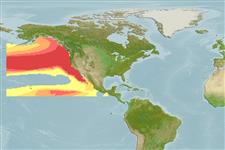Common names from other countries
>
Carangiformes (Jacks) >
Carangidae (Jacks and pompanos) > Caranginae
Etymology: Trachurus: Greek, trachys, -eia, -ys = rough + Greek, oura = tail (Ref. 45335); symmetricus: From symmetricus which means regularly formed - referring to the rough tail (Ref. 6885).
More on author: Ayres.
Environment: milieu / climate zone / depth range / distribution range
Ecología
marino; oceanodromo (Ref. 51243); rango de profundidad 0 - 400 m. Subtropical; 65°N - 13°N
Eastern Pacific: southeastern Alaska to southern Baja California, Mexico and the Gulf of California; reported from Acapulco in Mexico and the Galapagos Islands.
Tamaño / Peso / Age
Maturity: Lm ? range ? - 31 cm
Max length : 81.0 cm TL macho / no sexado; (Ref. 2850); common length : 55.0 cm TL macho / no sexado; (Ref. 9283); edad máxima reportada: 30 años (Ref. 766)
Short description
Claves de identificación | Morfología | Morfometría
Espinas dorsales (total) : 8 - 9; Radios blandos dorsales (total) : 28 - 38; Espinas anales: 1 - 2; Radios blandos anales: 22 - 33; Vértebra: 23 - 25. Small specimens may have an additional forward-directed spine at first dorsal origin (embedded in larger specimens).
Adults are often found offshore, up to 500 miles from the coast (Ref. 9283). They form large schools (Ref. 2850). Young frequently occur in school near kelp and under piers (Ref. 2850). They feed mainly on small crustaceans and fish larvae (Ref. 9283). Large individuals often move inshore and north in the summer (Ref. 2850). Marketed fresh, smoked, canned and frozen; eaten fried, broiled and baked (Ref. 9988).
Eschmeyer, W.N., E.S. Herald and H. Hammann, 1983. A field guide to Pacific coast fishes of North America. Boston (MA, USA): Houghton Mifflin Company. xii+336 p. (Ref. 2850)
IUCN Red List Status (Ref. 130435)
Can't connect to MySQL database (fbapp). Errorcode: Too many connections
